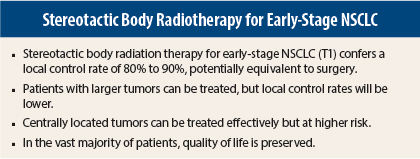Stereotactic body radiation therapy (SBRT) is safe and effective in early-stage non–small cell lung cancer (NSCLC), as it confers local control in 90% or more patients with T1 disease, according to Roy Decker, MD, PhD, Associate Professor in the Department of Therapeutic Radiology at Yale Cancer Center, New Haven, Connecticut. Dr. Decker described the use of SBRT in high-risk early-stage NSCLC patients at the 15th Annual International Lung Cancer Congress in Huntington Beach, California.
“In high-risk patients, SBRT appears to offer approximately equivalent control and survival when compared to surgical resection, in retrospective series,” he said. “I can say that SBRT is approximately as good as surgery.”
Transformative Study
Dr. Decker said that a multidisciplinary approach is always ideal. “Our guidelines state that all patients having SBRT who are at high risk should be evaluated by an experienced thoracic surgeon for minimally invasive surgery,” he said. “I never call a patient ‘inoperable’ without that consultation.”
However, results with stereotactic body radiotherapy are essentially equivalent to surgery, and may be preferred over surgery for some patients. The technique has been used in practice for 2 decades, and based on mature prospective trial data, the appropriate and inappropriate candidates for SBRT can now be identified, he said.
Several important studies have informed current SBRT practice in the United States. A number of years ago, phase II studies suggested that the failure pattern is primarily nodal or distant, and toxicity is more likely in the case of centrally located tumors, vs peripheral. This information formed the basis of the well-known Radiation Therapy Oncology Group (RTOG) 0236 trial, which enrolled 59 patients with T1 and T2 peripheral lesions outside of the zone of the proximal tracheobronchial tree.1
The study showed that patients with inoperable NSCLC receiving stereotactic body radiotherapy had a 3-year survival of 55.8%, high rates of local tumor control, and moderate treatment-related morbidity. Only one patient had a primary tumor failure, producing a 3-year primary tumor control rate of 97.6%. Three patients had a recurrence within the involved lobe, producing a 3-year primary tumor and involved lobe control rate of 90.6%. Median overall survival was 48 months. Rates of adverse events were 12.7% for grade 3 and 3.6% for grade 4. More patients died of other causes than of lung cancer.
“This study was transformative,” Dr. Decker said. “The findings are probably the best argument I can make for treating some high-risk patients with radiation.”
A subsequent population-based analysis from the Netherlands Cancer Registry examined the survival of early-stage NSCLC patients during three time periods, concluding the increase in survival between 2001 and 2009 was at least in part due to the increased use of SBRT over fractionated radiation.2
SBRT vis à vis Surgery
The issue of SBRT vs surgery has been examined through several comparative analyses. A retrospective comparison of patients with stage I NSCLC deemed ineligible for lobectomy found no significant difference in outcomes between stereotactic body radiotherapy and wedge resection.3 There were no differences in regional recurrence, locoregional recurrence, distant metastasis, or freedom from any failure. Risk of local recurrence was less with SBRT (4% vs 20%, P = .07), and while overall survival was higher with resection (87% vs 72%, P = .01), cause-specific survival was identical (94% with wedge, 93% with SBRT).
A similar finding was reached in another study of patients with stage I disease, 462 of whom underwent surgery and 76 who had SBRT. A propensity-matched analysis revealed similar rates of local recurrence and disease-specific survival between the two groups. Four-year local control was 90%, and there was no difference in cancer-specific survival.4
Japanese investigators conducted a retrospective review of 87 stage I patients who declined surgery and were treated with stereotactic radiotherapy, and found local control rates for T1 and T2 tumors at 5 years to be 92% and 73%, respectively. Five-year overall survival rates for stage IA and IB subgroups were 72% and 62%, respectively. The researchers concluded that the survival rate for SBRT is “potentially comparable to that of surgery.”
The most recent data come from a propensity-matched analysis of 64 patients treated with SBRT and 64 treated with minimally invasive surgery.5 Post-SBRT locoregional control rates were superior to surgery at 1 year (96.8% vs 86.9%) and 3 years (86.9% vs 82.6%, P = .04), but distant recurrences and overall survival were similar.
“None of these studies found that SBRT and surgery were the same, but they do tell us that outcomes with SBRT are in the same ballpark as those we get with surgery,” Dr. Decker concluded.
Prospective Trials
Only two prospective trials have been reported for operable patients—and remain unpublished. Their results are not as favorable, he noted.
RTOG 0618 was a small study of 26 patients with T1 and T2 disease in which the 2-year local and lobar failure rate was 19%.6 “This local failure rate is concerningly high,” Dr. Decker commented. “We await the publication, before we know what to make of this.”
Japan Clinical Oncology Group (JCOG) 0403 was a single-arm study of 64 operable patients.7 The 3-year local control rate was 86%, and overall survival rate was 76%. “This local control is not as good as expected, although we do not know how this was defined,” he remarked.
Unfortunately several randomized studies comparing surgery to SBRT have closed early due to poor accrual, including ROSEL (lobectomy vs SBRT), STARS (lobectomy vs SBRT with cyberknife) and ACOSOG Z4099/RTOG1021 (sublobar resection vs SBRT).
Pulmonary Function and Quality of Life
“The decision could come down to, ‘What’s the effect of SBRT on the patient’s quality of life and pulmonary function?’” Dr. Decker said. “The thoracic surgeon and I discuss whether the patient is a candidate for surgery or SBRT, and we try to parse out what the patient’s life will be like after treatment.”
In RTOG 0236, an analysis of patients’ pulmonary function following SBRT found no significant effect overall, but there were nonsignificant declines in both forced expiratory volume (FEV1) and diffusing capacity for carbon monoxide. This is consistent with what retrospective series have shown, and the impact of this could vary among patients, he said.
Quality of life has been examined in some studies. One from the Cleveland also revealed small declines in diffusing capacity of the lung for carbon monoxide, but no degradation in quality-of-life, no reductions in 6-minute walking distance, and no increase in patient-reported dyspnea.8
Few ‘Poor Candidates’ for SBRT
Not all patients with early-stage lung cancer are optimal candidates for stereotactic radiotherapy, though even suboptimal patients can have good outcomes, with caveats.
“Patients with centrally located tumors can be treated effectively, but they are at higher risk for side effects. And we think it’s safe to treat patients with larger tumors, but we have lower expectations of control,” he said.
For centrally located tumors that are small, reduced-dose SBRT can be effective, retrospective studies suggest. Even with a lower dose, however, grade 5 toxicities can occur.
In a study from Yale, in which 47 patients with central lesions received stereotactic body radiotherapy, four patients had grade 3 dyspnea and one developed hemoptysis that contributed to respiratory failure and death. Patients who developed grade 3 or more toxicity had larger tumors than those without toxicity (median diameter = 4.3 vs 2.9 cm, P = .02).
The 2-year lobar local control rate overall was 94%; this rose to 100% for patients receiving a biologic equivalent dose of 100 Gy or more and diminished to 80% among those receiving a lower dose. The authors concluded that SBRT for central lung tumors seems safe, but treatment of larger tumors carries an increased risk of high-grade toxicity.
Accrual is complete for RTOG 0813, which will treat patients at the highest dose levels and should be informative, he predicted.
For larger (T2) tumors in general—ie, those that are 4 to 5 cm—evidence is emerging that SBRT is effective, though local control is somewhat less than that seen with smaller tumors. A series of patients treated at Yale showed local control rates to be 75% to 80% in this population.
“This is no surprise. With a 5-cm tumor, you won’t get 90% local control,” he added. “If this patient has a good surgical option, that’s a better choice.”
Patients with poor pulmonary function at baseline also need not be excluded. A review of 423 patients, stratified by pretreatment pulmonary function, found that pulmonary function declined by 3.6% at 6 months and by 6.8% at 24 months.9 Interestingly, the largest loss was observed among patients with the best pulmonary function pretreatment; pulmonary function actually improved the most among patients with the worst baseline function. ■
Disclosure: Dr. Decker reported no potential conflicts of interest.
References
1. Timmerman R, Paulus R, Galvin J, et al: Stereotactic body radiation therapy for inoperable early stage lung cancer. JAMA 303:1070-1076, 2010.
2. Haasbeek CJ, Palma D, Visser O, et al: Early-stage lung cancer in elderly patients: A population-based study of changes in treatment patterns and survival in the Netherlands. Ann Oncol 23:2743-2747, 2012.
3. Grills IS, Mangona VS, Welsch R, et al: Outcomes after stereotactic lung radiotherapy or wedge resection for stage I non-small-cell lung cancer. J Clin Oncol 28:928-935, 2010.
4. Crabtree TD, Denlinger CE, Meyers BF, et al: Stereotactic body radiation therapy versus surgical resection for stage I non-small cell lung cancer. J Thorac Cardiovasc Surg 140:377-386, 2010.
5. Verstegen NE, Oosterhuis JWA, Palma DA, et al: Stage I-II non-small-cell lung cancer treated using either stereotactic ablative radiotherapy or lobectomy by video-assisted thoracoscopic surgery: Outcomes of a propensity score-matched analysis. Ann Oncol 24:1543-1548, 2013.
6. Timmerman RD, Paulus R, Pass HI, et al: RTOG 0618: Stereotactic body radiation therapy (SBRT) to treat operable early-stage lung cancer patients. ASCO Annual Meeting. Abstract 7523. Presented June 1, 2013.
7. Nagata Y, Hiraoka M, Shibata T, et al: A phase II trial of stereotactic body radiation therapy for operable T1N0M0 non-small cell lung cancer, Japan Clinical Oncology Group (JCOG0403). 52nd ASTRO Annual Meeting. Abstract 59. Presented November 1, 2010.
8. Videtic GM, Reddy CA, Sorenson L, et al: Support Care Cancer 21:211-218, 2013.
9. Guckenberger M, Kestin LL, Hope AJ, et al: Is there a lower limit of pretreatment pulmonary function for safe and effective stereotactic body radiotherapy for early-stage non-small cell lung cancer? J Thorac Oncol 7:545-551, 2012.



